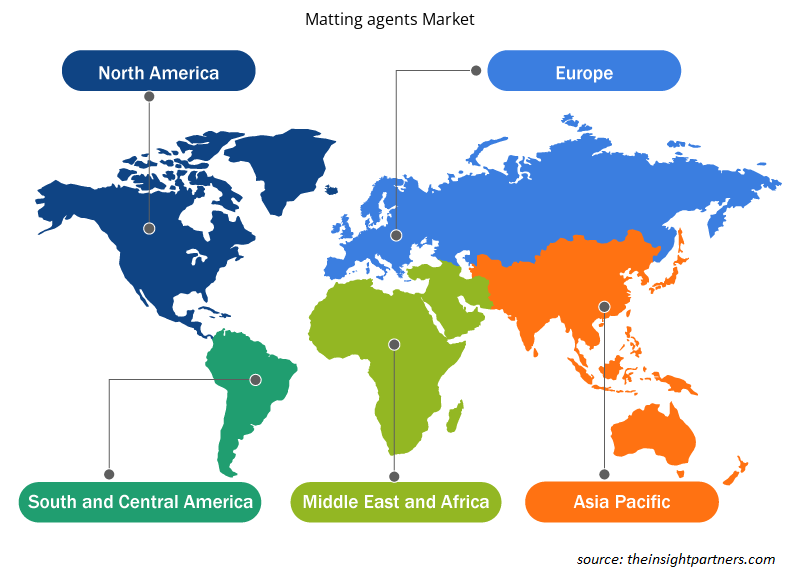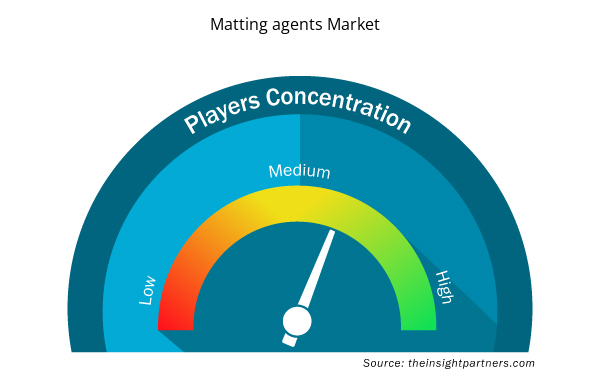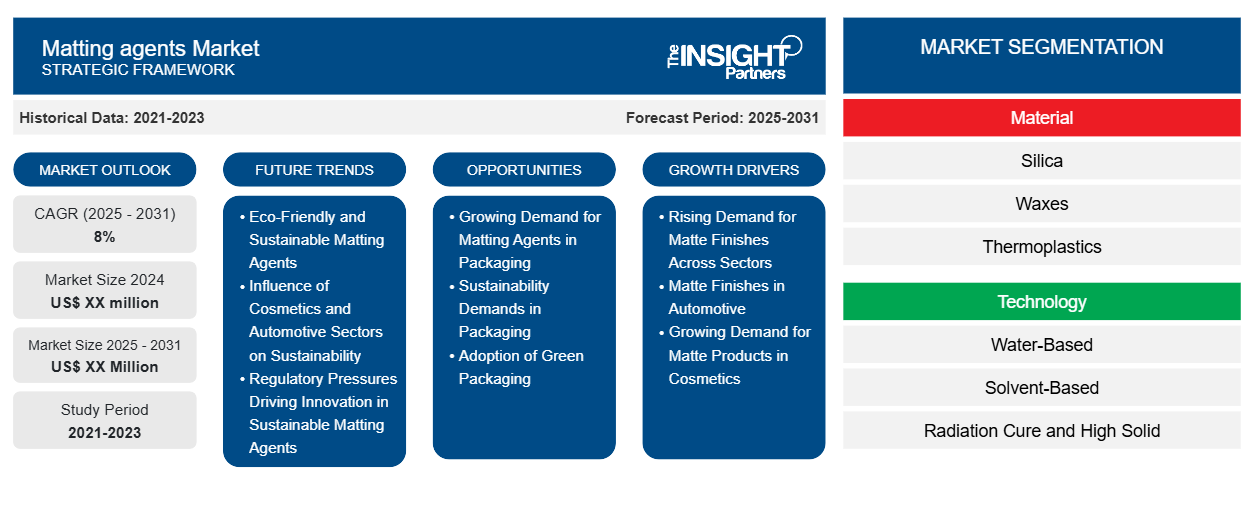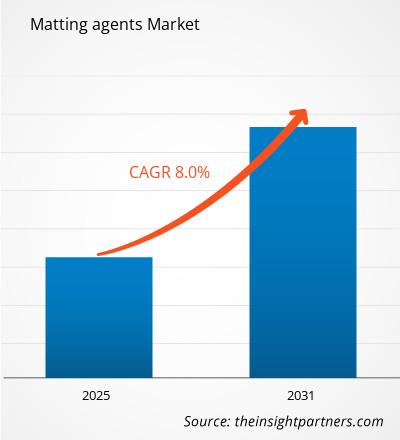Si prevede che il mercato degli agenti opacizzanti registrerà un CAGR dell'8% dal 2024 al 2031, con una dimensione di mercato in espansione da XX milioni di dollari nel 2024 a XX milioni di dollari entro il 2031.
Il report è segmentato per Materiale (Silice, Cere, Termoplastiche e Altri). Il report è anche segmentato in base a Tecnologia (A base d'acqua, A base di solvente, A polimerizzazione tramite radiazioni e Alto solido e Altri) e Applicazione (Industriale, Architettonico, Pelle, Legno, Inchiostri da stampa e Altri). L'ambito del report copre 5 regioni: Nord America, Europa, Asia Pacifico, Medio Oriente e Africa e Sud e Centro America e Paesi chiave in ogni regione. L'analisi globale è ulteriormente suddivisa a livello regionale e nei principali Paesi. Il report offre il valore in USD per l'analisi e i segmenti di cui sopra.
Scopo del rapporto
Il report Matting Agents Market di The Insight Partners mira a descrivere il panorama attuale e la crescita futura, i principali fattori trainanti, le sfide e le opportunità. Ciò fornirà spunti a vari stakeholder aziendali, come:
- Fornitori/produttori di tecnologia: per comprendere le dinamiche di mercato in evoluzione e conoscere le potenziali opportunità di crescita, consentendo loro di prendere decisioni strategiche informate.
- Investitori: condurre un'analisi completa delle tendenze in merito al tasso di crescita del mercato, alle proiezioni finanziarie del mercato e alle opportunità esistenti lungo la catena del valore.
- Enti di regolamentazione: regolamentano le politiche e le attività di controllo sul mercato allo scopo di ridurre al minimo gli abusi, preservare la fiducia degli investitori e sostenere l'integrità e la stabilità del mercato.
Segmentazione del mercato degli agenti opacizzanti
Materiale
- Silice
- Cere
- Termoplastici
Tecnologia
- A base d'acqua
- A base di solvente
- Polimerizzazione tramite radiazioni e alto contenuto di solidi
Applicazione
- Industriale
- Architettonico
- Pelle
- Legna
- Inchiostri da stampa
Geografia
- America del Nord
- Europa
- Asia-Pacifico
- America del Sud e Centro
- Medio Oriente e Africa
Personalizza questo report in base alle tue esigenze
Riceverai la personalizzazione gratuita di qualsiasi report, comprese parti di questo report, o analisi a livello nazionale, pacchetto dati Excel, oltre a usufruire di grandi offerte e sconti per start-up e università
- Scopri le principali tendenze di mercato in questo rapporto.Questo campione GRATUITO includerà analisi di dati che spaziano dalle tendenze di mercato alle stime e alle previsioni.
Fattori trainanti della crescita del mercato degli agenti opacizzanti
- Domanda crescente di finiture opache in tutti i settori: il principale motore del mercato degli agenti opacizzanti è la crescente domanda di finiture opache in vari settori, come l'automotive, la cosmetica e l'elettronica di consumo. Ultimamente le persone preferiscono finiture più opache per via dell'aspetto estetico e della riduzione dell'abbagliamento che fa apparire i prodotti sofisticati e moderni. Ciò sta spingendo i produttori a includere agenti opacizzanti nelle loro formulazioni.
- Finiture opache nell'automotive: miglioramento dell'appeal estetico: le finiture opache stanno diventando popolari per gli esterni delle auto nel settore automobilistico. Hanno un aspetto esclusivo e di alta qualità che differenzia il veicolo in un mercato competitivo. I produttori di automobili rispondono a questa richiesta di personalizzazione ed esperienza premium con rivestimenti innovativi che utilizzano agenti opacizzanti. Tali cambiamenti migliorano l'estetica dei veicoli e influenzano le decisioni di acquisto.
- Domanda crescente di prodotti opachi nei cosmetici: anche l'industria cosmetica sta vivendo un boom con l'uso di prodotti opachi, come rossetti e fondotinta. Le finiture opache sono popolari per le loro proprietà di lunga durata e controllo della lucentezza, che i consumatori preferiscono per un aspetto più naturale. Mentre i marchi continuano ad ampliare le loro linee di prodotti per soddisfare queste preferenze, la domanda di agenti opacizzanti efficaci continua ad aumentare, alimentando ulteriormente la crescita del mercato.
Tendenze future del mercato degli agenti opacizzanti
- Agenti opacizzanti ecosostenibili: la tendenza più emergente nel mercato degli agenti opacizzanti è la tendenza dei prodotti ecosostenibili. I consumatori stanno diventando sempre più consapevoli dell'ambiente, il che crea pressione sulle industrie affinché siano più ecologiche. Ciò costringerà i produttori a sviluppare agenti opacizzanti biodegradabili o basati su risorse rinnovabili in linea con gli obiettivi di sostenibilità globale e a migliorare il loro appeal sul mercato.
- Influenza dei settori cosmetico e automobilistico sulla sostenibilità: questa tendenza è caratterizzata da una maggiore influenza da parte di due settori principali: l'industria cosmetica e quella automobilistica. I produttori di automobili sono alla ricerca aggressiva di finiture ecocompatibili che offrano un aspetto opaco desiderato senza danneggiare la natura. Inoltre, molte aziende cosmetiche hanno risposto positivamente alle mutevoli preferenze dei consumatori, assicurando lo sviluppo di formulazioni opache prive di agenti opacizzanti tradizionali ma ecocompatibili. Ciò garantisce quindi il branding in termini di preferenze dei consumatori, il che consente a un'azienda di ottenere un posizionamento competitivo nei propri mercati.
- Pressioni normative che guidano l'innovazione negli agenti opacizzanti sostenibili: le pressioni normative contribuiscono anche a creare la domanda di agenti opacizzanti sostenibili. C'è stato un forte aumento delle normative ambientali a livello globale. Molti governi stanno fissando limiti ambientali, costringendo così le loro industrie a basse emissioni di carbonio. Per questo motivo, molte aziende iniziano a investire in ricerca e sviluppo per soluzioni di opacità nuove ed ecologiche. Ciò non solo contribuisce positivamente alle iniziative ambientali, ma fornisce anche nuove opportunità di mercato che spingono la crescita nel settore degli agenti opacizzanti.
Opportunità di mercato degli agenti opacizzanti
- Domanda crescente di agenti opacizzanti nel packaging: alcune delle applicazioni significative degli agenti opacizzanti includono il rivestimento per scopi di imballaggio. Gli imballaggi attraenti e funzionali continuano a guadagnare terreno, il che spinge i produttori a trovare mezzi più creativi per migliorare la presentazione del prodotto. Completare la finitura opaca desiderata rientra pienamente nel regno dell'attività degli agenti opacizzanti non solo in termini di estetica ma anche di caratteristiche pratiche come la prevenzione dell'abbagliamento.
- Esigenze di sostenibilità nel packaging: la domanda di una maggiore sostenibilità nel packaging è in aumento a causa dell'aumento delle spedizioni dirette ai consumatori. Il packaging deve essere sia attraente che sufficientemente robusto da resistere alla spedizione. Gli agenti opacizzanti possono migliorare l'efficacia dei rivestimenti utilizzati nel packaging per garantire che i prodotti appaiano attraenti quando vengono posizionati sugli scaffali, ma anche per resistere alla spedizione e persino al transito. Questa duplice applicazione degli agenti opacizzanti per l'aspetto estetico e la funzionalità li pone al centro delle strategie di packaging.
- Adozione di imballaggi verdi: la tendenza verso imballaggi verdi crea anche una nicchia per agenti opacizzanti rispettosi dell'ambiente. Mentre le aziende cercano di rispondere alla domanda dei consumatori che desiderano prodotti più responsabili ed ecologici, gli agenti opacizzanti biodegradabili o rinnovabili diventano essenziali. Questo sviluppo si adatta bene agli obiettivi di sostenibilità globale del mondo e sblocca opportunità di crescita nel mercato degli agenti opacizzanti per le aziende che hanno la capacità di cogliere le mutevoli preferenze dei consumatori.
Informazioni regionali sul mercato degli agenti opacizzanti
Le tendenze regionali e i fattori che influenzano il mercato degli agenti opacizzante durante il periodo di previsione sono stati ampiamente spiegati dagli analisti di Insight Partners. Questa sezione discute anche i segmenti di mercato degli agenti opacizzante e la geografia in Nord America, Europa, Asia Pacifico, Medio Oriente e Africa e Sud e Centro America.

- Ottieni i dati specifici regionali per il mercato degli agenti opacizzanti
Ambito del rapporto di mercato sugli agenti opacizzanti
| Attributo del report | Dettagli |
|---|---|
| Dimensioni del mercato nel 2024 | XX milioni di dollari USA |
| Dimensioni del mercato entro il 2031 | XX milioni di dollari USA |
| CAGR globale (2025 - 2031) | 8% |
| Dati storici | 2021-2023 |
| Periodo di previsione | 2025-2031 |
| Segmenti coperti | Per materiale
|
| Regioni e Paesi coperti | America del Nord
|
| Leader di mercato e profili aziendali chiave |
|
Agenti opacizzanti Densità degli attori del mercato: comprendere il suo impatto sulle dinamiche aziendali
Il mercato degli agenti opacizzante sta crescendo rapidamente, spinto dalla crescente domanda degli utenti finali dovuta a fattori quali l'evoluzione delle preferenze dei consumatori, i progressi tecnologici e una maggiore consapevolezza dei benefici del prodotto. Con l'aumento della domanda, le aziende stanno ampliando le loro offerte, innovando per soddisfare le esigenze dei consumatori e capitalizzando sulle tendenze emergenti, il che alimenta ulteriormente la crescita del mercato.
La densità degli operatori di mercato si riferisce alla distribuzione di aziende o società che operano in un particolare mercato o settore. Indica quanti concorrenti (operatori di mercato) sono presenti in un dato spazio di mercato in relazione alle sue dimensioni o al valore di mercato totale.
Le principali aziende che operano nel mercato degli agenti opacizzanti sono:
- Evonik Industries (Germania)
- Deuteron GmbH
- Jinsha Precipitated Silica Manufacturing Co. Ltd.
- Società anonima Thomas Swan and Co. Ltd.
- Gruppo Lorama
Disclaimer : le aziende elencate sopra non sono classificate secondo un ordine particolare.

- Ottieni la panoramica dei principali attori del mercato degli agenti opacizzanti
Punti di forza chiave
- Copertura completa: il rapporto esamina in modo completo i prodotti, i servizi, le tipologie e gli utenti finali del mercato degli agenti opacizzanti, fornendo una panoramica olistica.
- Analisi degli esperti: il rapporto è compilato sulla base della conoscenza approfondita di esperti e analisti del settore.
- Informazioni aggiornate: il rapporto garantisce la pertinenza aziendale grazie alla copertura di informazioni recenti e tendenze nei dati.
- Opzioni di personalizzazione: questo report può essere personalizzato per soddisfare le esigenze specifiche del cliente e adattarsi in modo appropriato alle strategie aziendali.
Il rapporto di ricerca sul mercato degli agenti opacizzante può quindi aiutare a guidare il percorso di decodificazione e comprensione dello scenario del settore e delle prospettive di crescita. Sebbene possano esserci alcune preoccupazioni valide, i vantaggi complessivi di questo rapporto tendono a superare gli svantaggi.
- Analisi storica (2 anni), anno base, previsione (7 anni) con CAGR
- Analisi PEST e SWOT
- Valore/volume delle dimensioni del mercato - Globale, regionale, nazionale
- Industria e panorama competitivo
- Set di dati Excel


- Sodium Bicarbonate Market
- Sports Technology Market
- Integrated Platform Management System Market
- Excimer & Femtosecond Ophthalmic Lasers Market
- Grant Management Software Market
- Military Rubber Tracks Market
- Adaptive Traffic Control System Market
- Clear Aligners Market
- Rugged Servers Market
- Emergency Department Information System (EDIS) Market

Report Coverage
Revenue forecast, Company Analysis, Industry landscape, Growth factors, and Trends

Segment Covered
This text is related
to segments covered.

Regional Scope
North America, Europe, Asia Pacific, Middle East & Africa, South & Central America

Country Scope
This text is related
to country scope.
Domande frequenti
Based on geography, Asia Pacific is expected to register the fastest CAGR from 2023 to 2031.
The report can be delivered in PDF/Word format, we can also share excel data sheet based on request.
Expansion in packaging coatings is one of the key opportunities for the market growth.
Evonik Industries AG, PPG Industries Inc, Huntsman International LLC, Imerys, W R Grace and Co. Conn, J M Huber Coporation, Altana, Arkema, The Lubrizol Corporation, and Akzo Nobel NV are among the leading players operating in the matting agents market.
Growing demand for matte finishes in various industries is driving the market growth
The Matting Agents Market is estimated to witness a CAGR of 8% from 2023 to 2031
Trends and growth analysis reports related to Chemicals and Materials : READ MORE..
1. Evonik Industries (Germany)
2. Deuteron GmbH
3. Jinsha Precipitated Silica Manufacturing Co. Ltd.
4. Thomas Swan and Co. Ltd.
5. Lorama Group™ Inc.
6. Axalta Coating Systems
7. Quantum Silicones, LLC
8. Huber Engineered Materials
9. Minchelman Inc.
10. Thomas swan and Company
The Insight Partners performs research in 4 major stages: Data Collection & Secondary Research, Primary Research, Data Analysis and Data Triangulation & Final Review.
- Data Collection and Secondary Research:
As a market research and consulting firm operating from a decade, we have published and advised several client across the globe. First step for any study will start with an assessment of currently available data and insights from existing reports. Further, historical and current market information is collected from Investor Presentations, Annual Reports, SEC Filings, etc., and other information related to company’s performance and market positioning are gathered from Paid Databases (Factiva, Hoovers, and Reuters) and various other publications available in public domain.
Several associations trade associates, technical forums, institutes, societies and organization are accessed to gain technical as well as market related insights through their publications such as research papers, blogs and press releases related to the studies are referred to get cues about the market. Further, white papers, journals, magazines, and other news articles published in last 3 years are scrutinized and analyzed to understand the current market trends.
- Primary Research:
The primarily interview analysis comprise of data obtained from industry participants interview and answers to survey questions gathered by in-house primary team.
For primary research, interviews are conducted with industry experts/CEOs/Marketing Managers/VPs/Subject Matter Experts from both demand and supply side to get a 360-degree view of the market. The primary team conducts several interviews based on the complexity of the markets to understand the various market trends and dynamics which makes research more credible and precise.
A typical research interview fulfils the following functions:
- Provides first-hand information on the market size, market trends, growth trends, competitive landscape, and outlook
- Validates and strengthens in-house secondary research findings
- Develops the analysis team’s expertise and market understanding
Primary research involves email interactions and telephone interviews for each market, category, segment, and sub-segment across geographies. The participants who typically take part in such a process include, but are not limited to:
- Industry participants: VPs, business development managers, market intelligence managers and national sales managers
- Outside experts: Valuation experts, research analysts and key opinion leaders specializing in the electronics and semiconductor industry.
Below is the breakup of our primary respondents by company, designation, and region:

Once we receive the confirmation from primary research sources or primary respondents, we finalize the base year market estimation and forecast the data as per the macroeconomic and microeconomic factors assessed during data collection.
- Data Analysis:
Once data is validated through both secondary as well as primary respondents, we finalize the market estimations by hypothesis formulation and factor analysis at regional and country level.
- Macro-Economic Factor Analysis:
We analyse macroeconomic indicators such the gross domestic product (GDP), increase in the demand for goods and services across industries, technological advancement, regional economic growth, governmental policies, the influence of COVID-19, PEST analysis, and other aspects. This analysis aids in setting benchmarks for various nations/regions and approximating market splits. Additionally, the general trend of the aforementioned components aid in determining the market's development possibilities.
- Country Level Data:
Various factors that are especially aligned to the country are taken into account to determine the market size for a certain area and country, including the presence of vendors, such as headquarters and offices, the country's GDP, demand patterns, and industry growth. To comprehend the market dynamics for the nation, a number of growth variables, inhibitors, application areas, and current market trends are researched. The aforementioned elements aid in determining the country's overall market's growth potential.
- Company Profile:
The “Table of Contents” is formulated by listing and analyzing more than 25 - 30 companies operating in the market ecosystem across geographies. However, we profile only 10 companies as a standard practice in our syndicate reports. These 10 companies comprise leading, emerging, and regional players. Nonetheless, our analysis is not restricted to the 10 listed companies, we also analyze other companies present in the market to develop a holistic view and understand the prevailing trends. The “Company Profiles” section in the report covers key facts, business description, products & services, financial information, SWOT analysis, and key developments. The financial information presented is extracted from the annual reports and official documents of the publicly listed companies. Upon collecting the information for the sections of respective companies, we verify them via various primary sources and then compile the data in respective company profiles. The company level information helps us in deriving the base number as well as in forecasting the market size.
- Developing Base Number:
Aggregation of sales statistics (2020-2022) and macro-economic factor, and other secondary and primary research insights are utilized to arrive at base number and related market shares for 2022. The data gaps are identified in this step and relevant market data is analyzed, collected from paid primary interviews or databases. On finalizing the base year market size, forecasts are developed on the basis of macro-economic, industry and market growth factors and company level analysis.
- Data Triangulation and Final Review:
The market findings and base year market size calculations are validated from supply as well as demand side. Demand side validations are based on macro-economic factor analysis and benchmarks for respective regions and countries. In case of supply side validations, revenues of major companies are estimated (in case not available) based on industry benchmark, approximate number of employees, product portfolio, and primary interviews revenues are gathered. Further revenue from target product/service segment is assessed to avoid overshooting of market statistics. In case of heavy deviations between supply and demand side values, all thes steps are repeated to achieve synchronization.
We follow an iterative model, wherein we share our research findings with Subject Matter Experts (SME’s) and Key Opinion Leaders (KOLs) until consensus view of the market is not formulated – this model negates any drastic deviation in the opinions of experts. Only validated and universally acceptable research findings are quoted in our reports.
We have important check points that we use to validate our research findings – which we call – data triangulation, where we validate the information, we generate from secondary sources with primary interviews and then we re-validate with our internal data bases and Subject matter experts. This comprehensive model enables us to deliver high quality, reliable data in shortest possible time.


 Ottieni un campione gratuito per questo repot
Ottieni un campione gratuito per questo repot